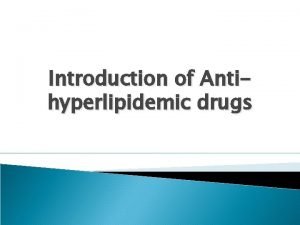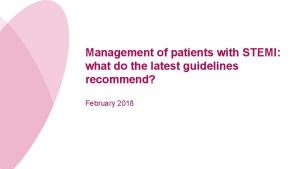EVALUATION OF ANTIPLATELET AND ANTIHYPERLIPIDEMIC AGENT DOSING ON

- Slides: 1

EVALUATION OF ANTIPLATELET AND ANTIHYPERLIPIDEMIC AGENT DOSING ON THROMBOTIC AND BLEEDING EVENTS IN LEFT VENTRICULAR ASSIST DEVICE PATIENTS Melanie Sharpnack, Pharm. D Candidate 1, 2; Sara Tarnowski, Pharm. D 1; Dennis Grauer, MS, Ph. D 2; Jennifer Loucks, Pharm. D, BCPS 1, 2; 1 Alissa Nathans, Pharm. D, BCACP 1 The University of Kansas Health System, Kansas City, KS; 2 The University of Kansas School of Pharmacy, Lawrence, KS BACKGROUND RESULTS • Left Ventricular Assist Devices (LVAD) are utilized to enhance survival and improve hemodynamics in patients with advanced heart failure • Device therapy comes with high risk of serious side effects including bleeding and thrombotic events due to physiological changes that occur from the continuous-flow pump • Current guidelines recommend systemic anticoagulation and antiplatelet therapy with warfarin (goal INR of 2 -3) in combination with aspirin, however, there is variation in recommended aspirin dosing • A post hoc analysis of the MOMENTUM 3 trial reviewed aspirin doses in patients with a Heart. Mate 3 LVAD, comparing aspirin 325 mg to aspirin 81 mg and outcomes were similar between both groups • HMG-Co. A reductase inhibitors (statins) are also commonly used in patients with LVAD and history of ischemic events to prevent recurrence, however, targets for low-density lipoprotein and efficacy of these agents in this population are unknown PURPOSE • Primary Outcome: • Incidence of serious bleeding or thrombotic event following index implantation with LVAD • Secondary Outcomes: • Changes in INR goal following event • Changes in antiplatelet therapy following event • Addition of targeted therapy (statin or somatostatin analog) following event METHODS Active patients n = 73 • Heart. Mate 3 (HM 3) n = 29 HW (n=36) HM 3 (n=29) p-value Age ± SD 57. 6 ± 11. 7 56 ± 12 0. 586 Male 30 (83) 27 (93) 0. 282 Caucasian 25 (69) 21 (72) 0. 794 Atrial Fibrillation 17 (47) 12 (41) 0. 638 Diabetes mellitus 13 (36) 16 (55) 0. 124 Hyperlipidemia 29 (81) 27 (93) 0. 172 Hypertension 27 (75) 21 (71) 0. 814 Current smoker 10 (28) 8 (28) 0. 986 84. 2 ± 36 0. 987 Baseline LDL ± SD 84. 1 ± 28. 9 VTE history 7 (19) 4 (14) 0. 546 Stroke history 3 (8) 2 (7) 1 GIB history 3 (8) 3 (10) 0. 781 Figure 1. Total Bleeding and Thrombotic Events in HW and HM 3 Patients 13 14 11 12 p=0. 42 10 6 p=0. 008 1 transferred to another center 2 patients not maintained on warfarin 4 patients with non -continuous device 0 Total thrombotic events HW Figure 2. Total Interventions Following Thrombotic Event 5 (42) 6 (50) 1 (8) Antiplatelet Intensification Addition of Antihyperlipidemic Agent INR Goal Intensification Total bleeding events HM 3 Figure 3. Total Interventions Following Bleeding Event 8 (35) • At baseline, there was no difference in demographics or risk factors prior to implantation between the two groups • In patients with a Heart. Ware device and thrombotic event, the most common intervention was antiplatelet therapy intensification(addition of dipyridamole or clopidogrel) • There are opportunities for continued medical optimization of patients antihyperlipidemic agents as well as support for smoking cessation to decrease risk of thrombotic events CONCLUSIONS • Patients implanted with Heart. Mate 3 device had a significantly lower incidence of thrombotic events and similar number of bleeding events when compared to patients with a Heart. Ware device • These results suggest decreasing the antiplatelet intensity may balance the risks more effectively as thrombotic risk is low and bleeding risk is sustained throughout the duration of Heart. Mate 3 pump support FUTURE DIRECTIONS • Program-level discussion to recommend lowering aspirin dose to 81 mg following index implant with Heart. Mate 3 device and standardization of management of complications • Development and implementation of pharmacist-driven statin and smoking cessation management for LVAD patients STUDY LIMITATIONS 7 8 2 • Heart. Ware (HW) n = 36 Table 1. Baseline Demographics, n (%) 4 • Retrospective chart review was performed on active patients implanted with an LVAD between 1/1/2015 and 9/1/2020 who were on maintenance warfarin therapy • Patients that expired or were transplanted during this time were excluded • If a serious bleeding event or ischemic event did occur additional data collected included: o Changes in antiplatelet therapy o Changes INR goal Exclusions: o Additions of targeted therapy • 2 patients DISCUSSION 11 (47) 4 (17) Antiplatelet Reduction Addition of Somatostatin Analog INR Goal Reduction • Small study size • INR goal following index implantation was changed from 2 -3 to 2 -2. 5 during the study window • Thrombotic events are from undetermined source • Variability in management following bleeding and thrombotic events REFERENCES 1. Nicholson JD, Kaakeh Y. Pharmacotherapy considerations for long-term management of patients with left ventricular assist devices. Am J Health Syst Pharm. 2018; 75(11): 755 -766. 2. Kirklin JK, Pagani FD, Goldstein DJ, et al. American Association for Thoracic Surgery/International Society for Heart and Lung Transplantation guidelines on selected topics in mechanical circulatory support. J Heart Lung Transplant. 2020 Mar; 39(3): 187 -219. 3. Saeed O, Colombo PC, Mehra MR, et al. Effect of aspirin dose on hemocompatibility-related outcomes with a magnetically levitated left ventricular assist device: An analysis from the MOMENTUM 3 study. J Heart Lung Transplant. 2020; 39(6): 518 -525. 4. Vieira JL, Pfeffer M, Claggett BL, Stewart GC, Givertz MM, Coakley L, Mallidi HR, Mehra MR. The impact of statin therapy on neurological events following left ventricular assist system implantation in advanced heart failure. J Heart Lung Transplant. 2020 Jun; 39(6): 582 -592. CONTACT INFORMATION Kansas Council of Health-System Pharmacy Annual Meeting: May 7 -8, 2021. Contact information: Alissa Nathans, Pharm. D, BCACP. Email: anathans@kumc. edu Disclosures: All authors of this presentation have nothing to disclose.

